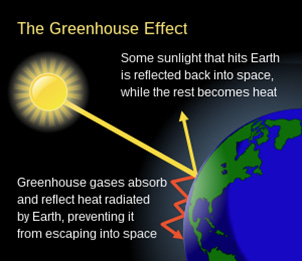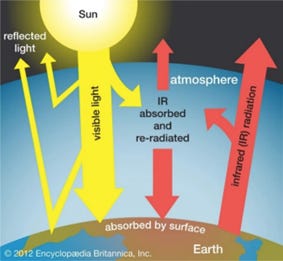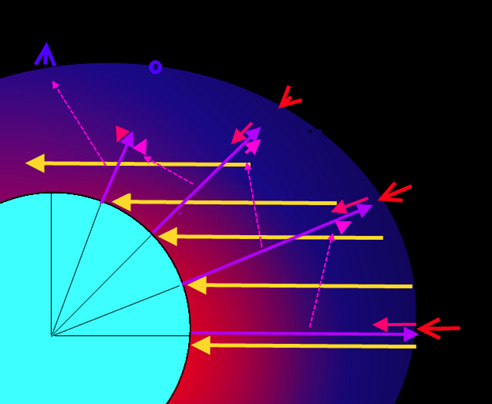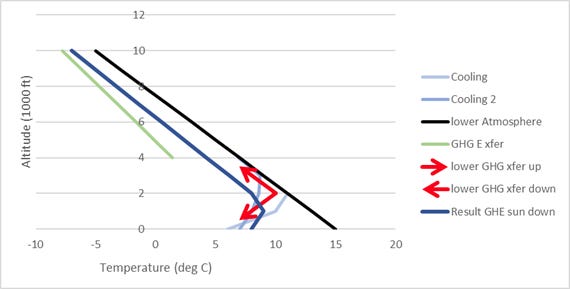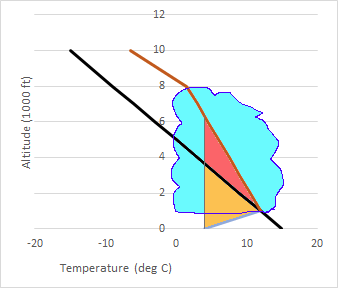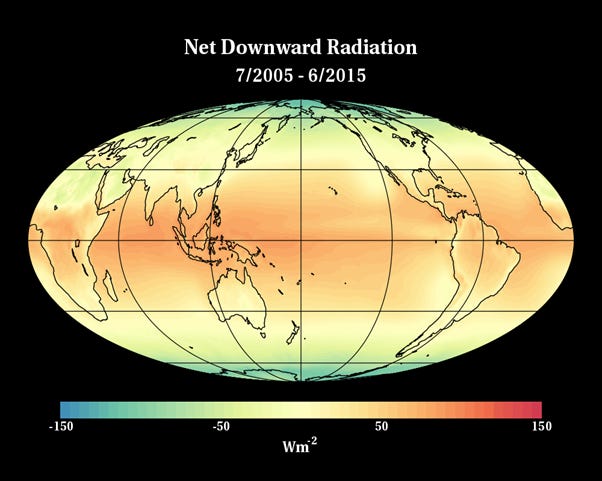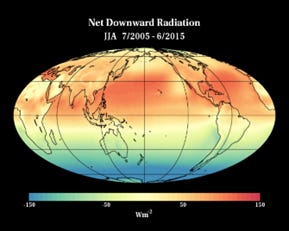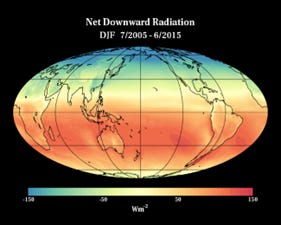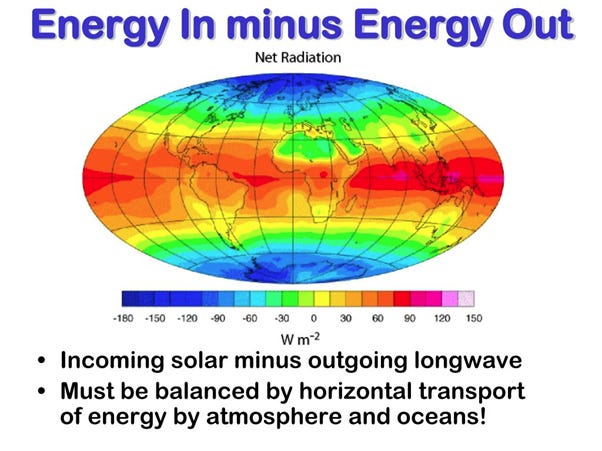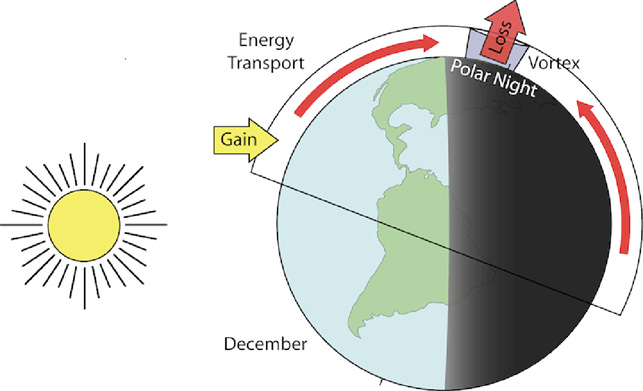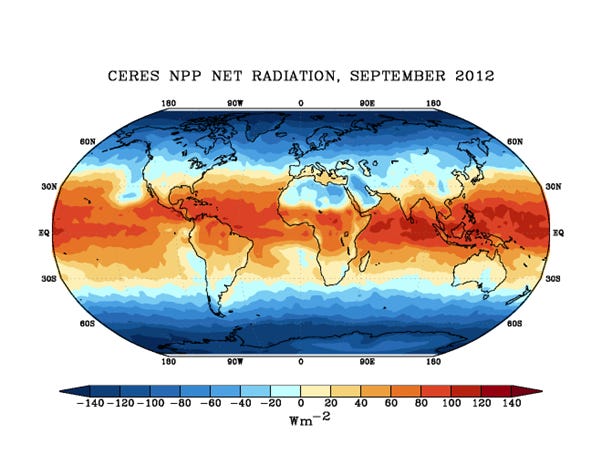The logic of the Greenhouse Effect
This article (and others) is also available on www.excogitatoris.site
1. Introduction
1.1. Climate change is a hot topic and a driver for many policies and society altering measures. The topic is so omnipresent hat the term `climate change’ has adopted a different meaning than the mere fact that the climate is changing.
1.2. In the long history of the earth, climate has always been changing and profound changes have taken place over thousands of years. There are many natural cycles acknowledged that range from hundreds of thousands of years to quasi-biennial oscillation that determine weather patterns and climate. That the climate is changing is not deniable, it has never been stable.
1.3. Though, the term ‘climate change’ has become synonym for the notion that the earth is recently rapidly warming due to man made changes to the atmosphere by emitting Carbon Dioxide (CO2) into the atmosphere. This notion of anthropogenic global warming has many supporters and is adopted by most mainstream media as a reality. It remains the question if recent global warming is within the realm of natural cycles or indeed a matter of anthropogenic global warming.
1.4. The basis for the anthropogenic global warming - hypothesis is the profound impact of the Greenhouse Effect of CO2 on the Earth’s Energy Balance. In a myriad of publications, the Greenhouse Effect is explained to the public with a model explaining the warming of the surface and lower atmosphere because of re-radiation of long wave radiation by so called `Greenhouse Gases’.
1.5. This paper will zoom into this textbook model of the Greenhouse Effect and analyse the appropriateness to properly explain the Greenhouse Effect and the Earth’s Energy Balance. The aim is to approach this analysis with common sense logic, using just basic facts of physics and meteorology.
2. The Textbook Model of Greenhouse Effect
2.1. The Greenhouse Effect is mostly presented in a one-dimensional model, where the Earth’s Energy Balance is driven by the dissipation of energy from the sun’s short-wave radiation that was absorbed by the surface of the earth, through long wave radiation from the surface into space. Some of this energy is absorbed by Greenhouse Gases and re-radiated to the surface. This re-radiation is generally presented as an energy flow up and down in the atmosphere.
2.2. Below are the main quotes of some popular websites explaining the Greenhouse Effect with the Textbook Model:
2.2.1. Wikipedia:
“The greenhouse effect is a process that occurs when energy from a planet's host star goes through the planet's atmosphere and heats the planet's surface, but greenhouse gases in the atmosphere prevent some of the heat from returning directly to space, resulting in a warmer planet.”
Also noted by Wikipedia: “The term greenhouse effect comes from a flawed analogy to greenhouses, which have transparent glass that passes sunlight but retains heat by physically restricting air movement; radiative effects are not involved.”
2.2.2. Encyclopedia Britannica
“The atmosphere allows most of the visible light from the Sun to pass through and reach Earth’s surface. As Earth’s surface is heated by sunlight, it radiates part of this energy back toward space as infrared radiation. This radiation, unlike visible light, tends to be absorbed by the greenhouse gases in the atmosphere, raising its temperature. The heated atmosphere in turn radiates infrared radiation back toward Earth’s surface. (Despite its name, the greenhouse effect is different from the warming in a greenhouse, where panes of glass transmit visible sunlight but hold heat inside the building by trapping warmed air.)”
2.2.3. NASA Earth Observatory
“Earth’s temperature begins with the Sun. Roughly 30 percent of incoming sunlight is reflected back into space by bright surfaces like clouds and ice. Of the remaining 70 percent, most is absorbed by the land and ocean, and the rest is absorbed by the atmosphere. The absorbed solar energy heats our planet.
As the rocks, the air, and the seas warm, they radiate “heat” energy (thermal infrared radiation). From the surface, this energy travels into the atmosphere where much of it is absorbed by water vapor and long-lived greenhouse gases such as carbon dioxide and methane.
When they absorb the energy radiating from Earth’s surface, microscopic water or greenhouse gas molecules turn into tiny heaters— like the bricks in a fireplace, they radiate heat even after the fire goes out. They radiate in all directions. The energy that radiates back toward Earth heats both the lower atmosphere and the surface, enhancing the heating they get from direct sunlight.”
3. Does the Textbook Model make sense?
3.1. The first question that comes to mind is; is the Textbook Model a good model? The Textbook Model summarises all processes that influence the Earth’s Energy Balance to a homogeneous surface that is constantly receiving Short Wave Radiation from the sun and only considers energy flow in one dimension. A model is a simplified version of reality to explain phenomena. But can a model be just too simple and open the possibility to draw the wrong conclusions about the climate?
3.1.1. The earth’s climate is determined by many processes. From long term change processes such as the Milankovitch cycles (changes in earth’s orbit around the sun and the tilt of the rotation axis of the world) to medium- and short-term changes in solar radiation, volcanic activity, lunar orbit variations and even cosmic radiation have some influence. But there are also many complex processes within the atmosphere that determine energy flow within the atmosphere.
3.1.2. In the end the Earth’s Energy Balance is about radiation energy being absorbed by the earth and its atmosphere versus radiation energy being dissipated into space, but there are many complex processes happening between the absorption of Short Wave Radiation from the sun and the emission of Long Wave Radiation of the earth and atmosphere into space. And whilst the Earth’s Energy Balance - story begins and ends with radiation, other forms of energy transfer do play an important role as well.
3.2. Is the Textbook Model an appropriate model to explain the Greenhouse Effect, the Earth’s Energy Balance and climate change?
3.2.1. The Textbook Model doesn’t make any distinction between when the sun is shining and when not or when the surface is warming and when it is cooling. The energy flow result of re-radiation processes differs distinctly under these conditions.
3.2.2. The Textbook Model doesn’t make any distinction between surfaces that receive much Short Wave Radiation - energy from the sun and surfaces that receive hardly any Short Wave Radiation. The local energy budget differs greatly between these surfaces.
3.2.3. The Textbook Model reduces the earth’s surface to some flat surface that just absorbs Short wave Radiation and warms up and then just emits Long Wave Radiation up from that surface. In fact, there are many other energy absorption processes where the energy eventually is emitted at another surface. Just consider warm ocean currents flowing to colder areas as an obvious example.
3.3. The model is so simplistic that, if you realise some basic meteorological facts, it cannot explain ‘the warming of the surface’. Before going into this, let’s acknowledge some basic logical facts.
4. Basic facts of Physics and Meteorology
4.1. The following statements are basic facts of thermo-physics:
4.1.1. All objects with a temperature above zero Kelvin emit thermal energy. This thermal energy is proportional to its temperature (E = σ T 4)
4.1.2. It takes the absorption of energy to increase an object’s temperature. Absorption is the net transfer of energy from another object. When an object absorbs radiation it doesn’t mean it absorbs energy. Only when an object absorbs more radiation than it emits, it absorbs energy.
4.1.3. Considering two objects exchanging thermal energy, the emittance of energy of object 1 received by object 2 counteracts the emittance of energy of object 2 towards object 1. Any (net) energy transfer flows from a warm object to a colder object. The net flow is proportional to the temperature difference. If only exchanging heat from a warm object to a colder object, the warmer will cool whilst the cold object will warm until both objects have the same temperature. (At that point both objects emit an equal amount of thermal energy to each other) Now the net energy flow stops, and a cold object can never spontaneously transfer any energy to a warmer object or warm that object.
4.1.4. Although it is pretty logical that you can’t warm an object by putting a colder object close to it, this logic is also determined in a law of physics, The 2nd Law of Thermodynamics.
4.2. Some basic facts of meteorology
4.2.1. The sun warms the earth’s surface, and the surface warms the atmosphere. Heat energy is transferred directly by conduction, convection, advection and radiation. The main process of heat distribution to the higher atmosphere is convection. Distribution of heat within the atmosphere is also achieved indirectly through ocean currents and movement of latent heat.
4.2.2. Warm air rises and when it is rising up it encounters lower pressure and will cool down as a result of that. After all the effect is that in general the air temperature will drop with altitude. This is referred to as the lapse rate. This term can cause some confusion as it often referred to as the temperature drop per unit of altitude. In a mathematical sense it is a negative coefficient. (Temperature decreases with increasing altitude). It is a fact that the upper atmosphere is generally colder than the surface and lower atmosphere.
5. Energy transfer to the surface?
5.1. Can energy be transferred to the earth’s surface?
5.1.1. Considering these basic facts, how is it possible that re-radiation from Greenhouse Gases warms the earth’s surface? There is no net energy flow from cold Greenhouse Gases to the warmer surface, so no extra absorption of energy, hence no warming.
5.2. Proponents of the populist Anthropogenic Global Warming - mantra claim that the textbook Greenhouse Effect story is not in violation of the 2nd Law of Thermodynamics.
Skeptical Science: “Due to the greenhouse effect, the total loss of that outgoing radiation is avoided and the cooling of Earth's surface is thereby inhibited” and “The Second Law does not state that the only flow of energy is from hot to cold - but instead that the net sum of the energy flows will be from hot to cold. That qualifier term, 'net', is the important one here. The Earth alone is not a "closed system", but is part of a constant, net energy flow from the Sun, to Earth and back out to space. Greenhouse gases simply inhibit part of that net flow, by returning some of the outgoing energy back towards Earth's surface.”
5.2.1. This explanation by Skeptical Science is contradicting itself. “Returning some of the outgoing energy back towards Earth’s surface”? But this would violate the 2nd Law of Thermodynamics. Radiation and Net Energy flow is conflated here. If the earth radiates more than it receives from the colder Greenhouse gas, net energy flow will be from the earth upward. True; the total loss of outgoing radiation to space is avoided as the upper atmosphere absorbs some of that energy. But this is just temporary, it doesn’t mean that the cooling of the earth is hereby inhibited. And it certainly does not mean that the surface is warming, as that can only happen when there is a net energy flow towards the surface and this can only happen in accordance with the 2nd Law of Thermodynamics when the Earth’s surface is cooler. Under limited circumstances this can happen but in general the surface is warmer than the atmosphere.
5.2.2. The returning energy from the colder upper atmosphere Greenhouse Gases only counteracts the flow of energy transmitted from the surface to the colder Greenhouse gases and when Greenhouse gases warm up, limits the transfer of energy of the surface to these Greenhouse Gases. Since there is no net energy transfer from the colder Greenhouse Gases to the surface, the surface doesn’t absorb any extra energy. It will just emit the original amount of energy (absorbed Short Wave Radiation from the sun) and since less energy is transferred from the warm surface to the still colder Greenhouse Gases, relatively more will be emitted into space.
5.2.3. And since the upper atmosphere is warmer after the absorption of some LWR from the surface, the temperature difference between the upper atmosphere and space has now increased, causing more net energy to be transferred from that upper atmosphere towards space. So logically you cannot claim that Greenhouse gases ‘trap’ energy or inhibit cooling. It temporarily holds some of the outgoing radiation and transfers it into space and to some colder areas in the atmosphere.
5.3. The Textbook Model cannot explain why the surface is warming if you truly take the energy flow logic into account. It only explains the warming of the upper atmosphere which, if you take only energy transfer by radiation into account, will lead to an earth and atmosphere of the same temperature and act as 1 body. Clearly the Textbook Model is lacking some sophistication! The Textbook Model is too simple, and the ‘classic’ warming of the surface explanation still violates the 2nd Law of Thermodynamics.
5.4. What about the classic example of noticeable Greenhouse Effect? The fact that the surface cools off much more on a clear night than when you have a layer of clouds over it, proves the effect of back-radiation of Greenhouse Effect. To explain this properly you must regard a more comprehensive view of radiation processes. The key elements in the “classic proof” of the Greenhouse Effect are; ‘cools’, ‘night’, ‘clouds’ and the implicit ‘over land’.
5.5. Let’s have a less aggregate view than the Textbook Model of the energy flow by radiation within the atmosphere, to analyse what is actually happening. Mind that radiation is not the only energy transfer mechanism within the atmosphere, but this will be revisited later in this paper.
6. A multidimensional view of energy flow by radiation
6.1. Daytime; the sun shines:
6.1.1. Short Wave Radiation from sun is absorbed by earth’s surface, It warms up and emits Long Wave Radiation (and warms the lower atmosphere). This Long Wave Radiation is partially absorbed by Greenhouse Gases and this is re-emitted in all directions by the Greenhouse Gases.
6.1.2. But what net energy flow does this result in? Most of it will just emit into space but some will stay in the atmosphere. Since energy only transfers from warm to cold. This energy is only absorbed by colder parts of the atmosphere. This is at the same latitude only higher up in the atmosphere given the generic negative lapse rate. Other areas within the atmosphere where it is colder is of course at higher latitudes.
6.1.3. The effect of re-radiation by Greenhouse Gases when disregarding the influence of the surface is that it will transfer energy from lower atmosphere to higher atmosphere (where it is colder). So lower atmosphere will cool and higher atmosphere will warm up resulting in reducing the lapse rate. Disregarding everything else taking place in the atmosphere, theoretically i.a.w. the laws of thermodynamics, this will continue until lower and higher atmosphere are of the same temperature. The natural effect of re-radiation is increasing the lapse rate (bringing it to zero).
6.1.4. But during the day the sun keeps warming the surface and the lower atmosphere which don’t get the chance to cool off. The overall result, when the sun shines is that the Greenhouse Effect increases the lapse rate.
6.1.5. Now because the upper atmosphere is warmed up, it re-radiates more and the emittance towards the surface will reduce the transfer of energy from the surface to the upper atmosphere Greenhouse gases. But this extra energy flow does NOT constitute a net energy flow and thus no energy is transferred to the surface and thus the surface will not absorb any extra energy. The surface will just emit the same amount of energy based on the warming of the sun locally. (= locally absorbed Short Wave Radiation)
6.1.6. Because energy will also flow to higher latitudes within the atmosphere, this will contribute the warming of the upper atmosphere at this higher latitude. The temperature difference between the warmer surface directly below (on this higher latitude) becomes smaller. This will reduce the energy transfer from the surface direct to the upper atmosphere Greenhouse Gases at that latitude. And thus, more of the surface Long Wave Radiation at that latitude will emit into space. This aspect is completely ignored in the Textbook Model.
6.1.7. This energy flow basically transfers energy within the atmosphere to higher latitudes and reduces the energy absorption effect of the local Greenhouse gases in the upper atmosphere. It is a fact that the lapse rate of the troposphere increases (less negative) with latitude.
Yellow arrow: Incoming Short Wave Radiation from sun
Purple arrow: Surface Long Wave Radiation emitted by surface = effective Short Wave Radiation received absorbed locally (due to inclination of surface in relation to incoming solar rays)
Small red arrow: Local downward portion of re-radiation of Greenhouse Gases (due to night time cooling of surface.)
Violet dashed arrow: Greenhouse Effect contributing to meridional energy flow.
Violet arrow: Limiting local downward flow due to meridional re-radiation
Large red/blue arrow: overall result of top of atmosphere (TOA) net energy flow due to Greenhouse Effect.
[Note: Arrows are not in proportion. They are just to demonstrate the direction of energy flows and interaction on different latitudes]
6.1.8. Given the fact that the effective amount of local Short Wave Radiation absorbed, also decreases with latitude due to the inclination of the earth’s surface in relation to the direction of incoming solar rays, there will be a point at which more Long Wave radiation energy from the earth/atmosphere system is emitted into space than Short Wave Radiation received locally by the sun.
6.1.9. Greenhouse Effect contributes to meridional energy flow and will assist in cooling the earth.
6.2. Night time; the surface cools
6.2.1. No incoming Short Wave Radiation from the sun, the surface keeps emitting Long Wave Radiation and dissipating energy up and will be cooling. The transfer of energy will still go from warm to cold and mostly energy is transferred towards the higher colder atmosphere (and into space of course). But the surface will cool beyond the temperature just above it and this will cause some effective energy transfer flow downwards due to the Greenhouse Effect. This will ripple through at higher altitudes with decreasing effect, but it will dampen the natural trend of thermal energy transfer of increasing the lapse rate to zero. This effect mainly takes place at the very lower levels of the atmosphere and is proportionally low to the energy flow upward.
6.2.2. So, at night there will be some net energy flow vertically downward in the atmosphere due to the Greenhouse Effect and this will dampen cooling of the surface.
But to generalise this effect as an aggregate effect is misleading as the meridional flow, which takes place day and night is completely ignored in the Textbook Model.
Besides this effect is only noticeable in the very lower parts of the atmosphere and insignificant in comparison to the overall upward and outward flow of energy.
6.2.3. This real downward energy flow effect of Greenhouse Effect is of course more profound when you have a larger layer of lower atmosphere being colder than layers above it. On land at night the lower atmosphere will cool down significantly to create an inversion layer. (A layer of the atmosphere where the lapse rate is positive; the temperature increases with altitude)
6.2.4. When also a cloud layer sits above this inversion layer, you now will notice the Greenhouse Effect at night as it will not cool as much as on a clear night. It is remarkable how Anthropogenic Global Warming - enthusiasts use this classic example of noticeable Greenhouse Effect. Firstly, cloud layer is water vapour that has a larger Greenhouse Effect than CO2. They argue it is about the principle of the Greenhouse Effect and even assume that Water vapour will ‘enhance’ the Greenhouse Effect of CO2.
6.2.5. The real downward energy flow effect of GHE is of course also more profound when you have a larger layer warmer atmosphere above the inversion layer. This also happens with clouds. Clouds are basically moist saturated air where condensation is taking place and some latent energy is released. This causes an increased (less negative) lapse rate. This causes a larger area where GHG are able to have a net energy flow downward and ‘warm’ the surface and earth, actually dampening the cooling.
6.2.6. Clouds (Water vapour) due to their latent energy strengthen the Greenhouse Effect when the surface is cooling, but to attribute this effect purely to the generic Greenhouse Effect (and that of CO2) is disingenuous. With the assumption of the ‘enhanced’ Greenhouse Effect by water vapour, the increase in albedo (reflection of Short Wave Radiation by clouds in the first place), the fact this only works with an inversion layer (mostly only at night over land), and the contribution to the meridional energy flow are ignored.
6.3. If you really follow the energy in a broader perspective than a flat earth with a one-dimensional atmospheric radiative energy flow, respecting common sense and laws of physics, you can conclude that the Greenhouse Effect dampens some cooling at night, but also dampens warming by transferring energy to higher latitudes and enhancing dissipation of energy into space at higher latitudes.
7. Earth’s Energy Balance in a broader perspective.
7.1. Of course, the concept of the Earth’s Energy Balance can also be viewed in a broader concept than the one-dimensional flow in the Textbook Model. To explore this, it is good to have a look at images of NASA’s satellite project CERES.
7.1.1. The Clouds and the Earth’s Radiant Energy System (CERES) project provides satellite-based observations of clouds and the earth’s radiation budget (ERB; the difference between the amount of sunlight absorbed by Earth and the amount of infrared energy emitted to space). It uses measurements from CERES instruments flying on several satellites along with data from many other instruments to produce a comprehensive set of ERB data products for climate, weather and applied science research.
7.2. With these images, it becomes clear that the earth absorbs energy around the equator and dissipates energy around the poles
7.2.1. In fact, examining the seasonal images of CERES, you can conclude that most of the winter hemisphere is net dissipating energy into space.
7.3. The poles are still emitting Long Wave Radiation into space during the polar winter, even when it doesn’t receive any solar Short Wave Radiation for months. It is evident that energy that is absorbed around the equator is transferred to higher latitudes where it is dissipated into space. This meridional energy flow is the key to the Earth’s Energy Balance.
7.4. The Textbook Model completely ignores the meridional energy flow and all the processes that are involved. The Greenhouse Effect contributes to this meridional energy flow, but there are more modes of energy transport that are involved with the meridional energy flow. An obvious example; a warm ocean current that transports energy to the poles brings this energy to an area where it dissipates this energy into space through outgoing Long Wave Radiation.
7.5. Anthropogenic Global Warming - enthusiasts may argue; but also at the poles CO2’s Greenhouse Effect will ‘trap’ energy. But that trapping is only temporary. In the continuous process, it is evident by the CERES images that the earth/atmosphere net dissipates energy around the poles. As demonstrated before, the Greenhouse Effect contributes to the meridional flow which relatively reduces the ‘trapping capacity of energy’ by the upper atmosphere at the local area at that higher latitude.
8. Carbon Dioxide versus Water as Energy absorbing agent
8.1. Besides, is CO2 such a powerful energy trapping agent? The CERES images reveal other interesting facts:
8.2. The Sahara
8.2.1. The Sahara is an overall net energy dissipating area. Why is the Sahara a net radiation dissipating area whilst most areas around the same latitude are net radiation absorbing areas? If CO2 GHE energy ‘trapping’ effect is so profound, why is it not working around the Sahara? The obvious answer is; the absence of water.
8.2.2. Who would think that the element that is unique for our blue planet, the prerequisite for many of features of our world, such as the existence of life, would not have a dominant role in energy transport within the earth/atmosphere system, the meridional flow and the Earth’s Energy Balance?
8.3. Net dissipating areas over water
8.3.1. But there are areas above water that are also deviating from most areas around the same latitude and show a net dissipating regime instead of a net absorbing effect as other areas of the same latitude? The areas to the West side of North and South America for example. These areas are characterised by cold ocean currents. It reveals an important feature of water that CO2 doesn’t have. The ability to transfer energy to latent energy.
8.3.2. Latent heat is that energy that water absorbs when it evaporates. This energy is released when condensation takes place.
8.3.3. Cold water takes more energy to evaporate. With a similar amount of incoming Short Wave Radiation from the sun at the same latitude, cold water is evaporating less and transferring less energy to latent energy. If less energy is transferred to latent energy, it will transfer more energy to heating up the water and consequentially outgoing Long Wave Radiation. In other words, cold water will absorb less energy to be transported to other areas within the earth/atmosphere system and dissipate more directly as outgoing Long Wave Radiation and thus contribute to a more net radiation dissipating regime at the local area.
8.4. Energy characteristics of CO2 versus Water.
8.4.1. The ability to absorb energy is of course an indicator for the role of elements to contribute to the complex processes that determine the Earth’s Energy Balance.
8.5. Heat capacity.
8.5.1. Heat capacity is the amount of heat required to change the temperature of a substance by one degree.
8.5.2. Have you ever swum in undisturbed water like a lake on a summer day. Did you notice how the upper layer of water is significant warmer than when you dive into the depth of the lake. What is your estimate of the thickness of the layer that has increased a noticeable amount of degrees because of the warming from the sun. Hold that thought.
8.5.3. With a rudimentary simple calculation one can compare the capacity of all CO2 in the atmosphere with the capacity the earth’s oceans surface to absorb energy. See this attachment for calculations.
This depth is 1.5 mm!
8.6. Vaporization and Latent Energy
8.6.1. Heat of Vaporization is the amount of energy that must be added to a given mass of a liquid to evaporate it into a gas. This energy is stored in the gas as latent energy and releases when the gas condensates back to a liquid form again.
8.6.2. The heat capacity of all the world’s CO2 is dwarfed by the heat capacity of water. Now consider the amount of energy that it takes to evaporate 1 litre/kg of water versus the energy it takes to increase the temperature of 1 litre/kg of water by 1 degree.
This is 2465 kJ versus 4 kJ!
8.6.3. It is evident that much of the Short Wave Radiation energy absorbed by the earth’s surfaces perpendicular to the sun is temporary stored in latent energy, which can move to other areas of the earth’s surface.
8.6.4. Everybody knows that large low-pressure systems with lots of clouds (e.g. cyclones), and even single thunderstorms can release an incredible devastating amount of this latent energy.
8.6.5. This latent energy is also a major factor in the meridional energy flow that determines the Earth’s Energy Balance.
8.6.6. The latent energy that is daily being transferred in the atmosphere is hundreds of times bigger than all the daily energy required for recent “catastrophic” climate change. (see attachment) It is just common sense that it is very probable that water is responsible for imbalances in the Earth’s Energy balance due to its role and capacity in causing variations in the meridional energy flow.
8.7. It is beggar believe that given the thermo-physical characteristics of water versus CO2, the Anthropogenic Global Warming - enthusiasts claim CO2 to be the thermostat of the world.
8.7.1. Just consider the following common-sense question:
Why do our TV-weather-presenters often mention all kind of ocean temperature indices (e.g. ENSO) to clarify short to medium term climate trends, whilst long term guesses are based on CO2? Does one have an empirical relation whilst the other doesn’t, and is more of a believe system?
9. Conclusions
9.1. By just considering some basic facts of physics and meteorology, it is evident that the Textbook Model of the Greenhouse Effect is deeply flawed. To truly consider the foundations of what determines the Earth’s Energy Balance and climate, more dimensions must be considered.
9.2. The Earth’s Energy Balance is not a matter of a one-dimensional energy flow vertically up and down in the atmosphere as the flawed Textbook Model suggests, but a balance between energy absorbed around the equator and dissipated into space at the higher latitudes. Meridional energy flow is the determining process in establishing this balance.
9.3. Meridional energy flow is enhanced by the Greenhouse Effect but the role of CO2 in this energy flow is limited. Water is the driving element in the meridional energy flow. It is a more powerful Greenhouse Gas than Carbon Dioxide, but moreover, it also has other thermo-physical characteristics (such as the ability to transport latent energy) that drive the meridional energy flow. Water is the thermostat element of the world, not CO2.
10. Discussion.
Climate science is a complex area that involve many disciplines of science. By educating the public with a Textbook Model that is deeply flawed seems contra productive in the right understanding of the complexity and factors that influence the climate. It seems that it has become a propaganda tool in a politicised cult.
Since the Anthropogenic Global Warming - hypothesis has become a hot political topic and is generally adopted by mainstream media as a fact, though unproven, it pivots grants for scientific research and development in a politically correct direction, which hampers the development of objective climate science.
All the factors of influence on the meridional energy flow, such as the interaction of the dynamics within the stratosphere on the dynamics in the troposphere, are not fully explored yet. Also, the many assumptions regarding feedback mechanism have not been confirmed by empirical science.
Climate science is in its infancy. The popular views are driven by models and insufficiently backed up by empirical science. The cult that has developed around the Anthropogenic Global Warming - hypothesis has caused a group think and is hampering the maturing of climate science.




